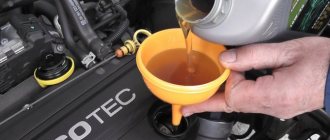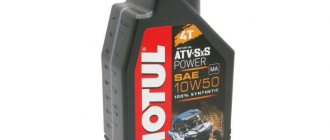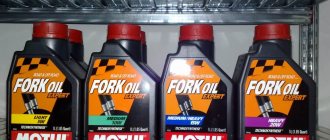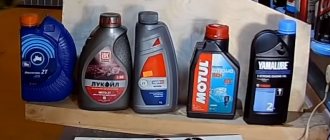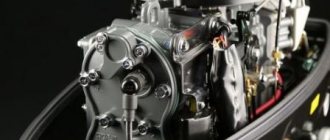Any equipment equipped with an internal combustion engine requires periodic replacement of the lubricant - oil. With timely maintenance, the engine can operate without breakdowns for quite a long time, without creating any problems for the owner of the vehicle. However, changing the oil in a motorcycle must be carried out in full accordance with strict rules - otherwise serious problems cannot be avoided.
Preparation
The first step is purchasing the oil that you are going to pour into the motorcycle engine. Remember that it must exactly match the parameters specified by the vehicle manufacturer. This applies to viscosity, as well as to the presence of special additives in the technical fluid. For two-stroke engines, a special oil is produced that is added to gasoline, so here we will look at replacing the lubricant in a four-stroke engine. “Two-stroke” oil cannot be poured into it, since it is not designed for long-term use and can cause damage to the power unit.
Before changing the oil, the engine must be flushed, since remnants of old fluid and chips accumulated as a result of wear of internal components can quickly damage the unit. The best option is to purchase flushing fluid, which is added to the old oil. It effectively removes all foreign objects from the hydraulic system and does not reduce the life of the power unit. In addition, there is a flushing agent that is added after the old oil has been removed from the engine. In any case, you should follow the recommendations of the fluid manufacturer - when flushing the engine, you need to start the motorcycle and let it run for 10-15 minutes, depending on what is indicated on the canister.
Draining the technical fluid is carried out only when the engine is warm - it must run for at least 2-3 minutes at idle so that the oil temperature reaches 100 degrees and its viscosity decreases significantly. Since you will have to deal with such a high temperature, prepare thick gloves in advance that will protect your hands from painful and difficult-to-heal burns. First you need to find the drain bolt, which is usually located at the bottom of the power unit, and in motorcycles with a dry sump - on the frame. There may be a plastic protection on it - it must be carefully bent to gain access to the neck.
Taking the key to 17, carefully begin to turn the bolt counterclockwise - if you sharply pull it in the opposite direction, you will not be able to avoid crankcase failure. When the bolt turns easily, quickly turn it out with your hands and remove your palms before hot oil pours on them. The lubricant will flow for approximately 15 minutes due to its high viscosity. To ensure complete removal of used oil, you can rock the motorcycle sideways to speed up the process. The oil should be collected in a previously prepared container so as not to cause damage to the environment or create a fire hazard.
If a bolt falls into a can of oil, try to get it out as quickly as possible using a wire hook or a powerful magnet. If dropped in such a way, its sealing copper washer may be damaged, which will lead to depressurization of the lubrication system. In such cases, you need to purchase a new bolt, since repairing it will not provide guaranteed reliability.
How to replenish the amount of lubricant?
If, when measuring the volume of car oil, you notice that it is not enough, you need to top up to increase the amount of oil. It’s not so scary if during a long trip the lubricant level drops to the minimum mark. It's worse when it fell significantly lower. In this case, you need to immediately add oil, right on the road.
Topping up is carried out through the oil filler cap, which you will see at the top of the engine. Often there are different inscriptions on it - signs like Oil Fill. In certain cases, a mark is applied to the surface of the cover indicating the type of optimal lubrication.
Remove the cover and install a watering can into the hole. Fill slowly. It is advisable to add oil in small portions. It is necessary to stop from time to time so that the fairy tale settles in the crankcase. After topping up, you need to check the volume again. Pull out the dipstick and test again.
You will also be interested in:
Replacement
When there is no old technical fluid in the lubrication system, you will need to change the oil filter to get rid of the chips or dirt accumulated in it. On some motorcycles it is located on the surface of the motor, while on others you have to remove the plastic lining and protective components to gain access. It is better to remove the oil filter using a special puller or a wrench with a chain, so as not to damage the threads. An emergency option is to pierce the body of the cleaning element with a screwdriver and use it as a lever. However, you need to make sure that the rod does not touch other components of the engine and fuel system.
A little hot oil may spill out of the filter mounting hole, so you should not remove the container for collecting it and gloves yet. A little clean oil is first poured into the new part. It is also necessary to lubricate the rubber O-ring to ensure the tightness of the hydraulic circuit. The filter is twisted until it stops by hand, after which it is pulled out a quarter turn with a wrench. However, you should not show excessive enthusiasm - a broken thread can cause complex, expensive repairs.
After screwing on the filter, reinstall the drain plug and plastic protection. Experts who know how to change the oil on a motorcycle advise to stock up on a funnel in advance that will fit well against the walls of the filler neck. If the diameter differs significantly, some of the lubricant may splash out, which leads to contamination of the vehicle. The filler plug is screwed on as tightly as possible, but you should not be zealous here either. To check the oil level, you need to run the engine for 2-3 minutes and then cool it for 5 minutes.
Lack of oil in a motorcycle engine often causes cylinder scuffing, which requires a major overhaul of the power unit. Therefore, if the level on the dipstick is below the minimum allowable, it is necessary to add the required amount of lubricant, and then repeat the procedure with warming up. Excessive amounts of lubricant also negatively affect the reliability of two-wheeled vehicles - so you should not be lazy to drain the excess if there is any. The most common problems associated with oil overfilling are squeezed out oil seals and seized pistons. Therefore, it is necessary to follow the manufacturer’s instructions, which are indicated in the instructions or on the official website.
Characteristics of oils for two-stroke engines
The most common uses for two-stroke engines are motorcycles and boats. But they can also be used on snowmobiles and lawn mowers, saws and vans.
While oil circulates in four-stroke engines, in two-stroke engines it is introduced into the fuel. In older models, a certain amount of oil was manually introduced into the fuel tank. Modern designs use an automatic dosing system. But the design of these engines leads to the emission of a large amount of fresh mixture with exhaust gases.
In order for two-stroke engines to operate more reliably, they need to be provided with higher quality oils. Such oils must have anti-wear properties, have cleaning functions, do not form deposits, mix well with fuel, and have good fluidity.
Two-stroke engine oil consists of 85-98 percent base oil. And the rest is additives that give it the properties it needs.
Table 1. API classification.
| Class | Description |
| API TA | Motor oils for two-stroke engines of small mopeds, lawn mowers and other similar equipment. |
| API TB | Motor oils for low-power two-stroke motorcycle engines. |
| API TC | Motor oils for two-stroke engines operating on land. These motor oils can be used in cases where the engine manufacturer requires the oil to comply with API TA or API TB classes. |
| API TD | Motor oils specially formulated for two-stroke outboard engines |
Table 2. JASO classification.
| Class | Description |
| JASO FA | For two-stroke engines of motorcycles and other cars (oils are intended for use in developing countries). |
| JASO FB | For two-stroke engines of motorcycles and other machines (minimum requirements for use in Japan). |
| JASO FC | For two-stroke engines of motorcycles and other cars, smokeless motor oil (main oil for use in Japan). |
| JASO FD | For two-stroke engines of motorcycles and other cars, smokeless motor oil with improved engine cleanliness characteristics compared to FC (the highest requirements for 2-stroke oils in Japan). |
Table 3. ISO classification.
| Criteria for evaluation | ISO-L-EGB (incl. JASO FB) | ISO-L-EGC (incl. JASO FC) | ISO-L-EGD |
| Lubrication properties | >95 | >95 | >95 |
| Smokiness | >45 | >85,2 | >85 |
| Deposits in the exhaust system | >45 | >90 | >90 |
| Cleaning effect | > 85 (1 hour test) | > 95 (1 hour test) | > 125 (3 h tests)* |
| Piston cleanliness | > 85 (1 hour test)*) | > 90 (1 hour test)*) | > 95 (3 hours of testing)* |
Correct oil change
The procedure should be performed in a garage in good lighting and at normal ambient temperatures. If the garage is not heated, it is better to avoid changing the oil in winter - it may thicken and not completely drain from all moving joints, which will subsequently cause them to break. The garage must be clean so that dust and other foreign impurities do not get into the oil - this is why the procedure is not recommended to be performed in the open air. After replacing the technical fluid, the engine should be run in, which will allow it to achieve a high level of reliability. You need to break in the motorcycle at medium speeds - at idle speed, solid deposits can form in the hydraulic system, and at high crankshaft speeds, the engine can wear out very quickly.
How often do you need to change the oil in a motorcycle engine, and what factors influence this?
How often should you change the oil in your motorcycle engine? The answer to this question is not as obvious as it looks in the operating instructions... After all, the conditions of this very operation may differ, and quite significantly, from the region in which the equipment is used and ending with the driving style of a particular owner.
In addition, the road infrastructure is also of considerable importance (compare, for example, the unlimited autobahns of Germany and the road network of Karelia, where dirt roads are quite common).
The oil dipstick and inspection window in the crankcase of your motorcycle will be invaluable assistants in this delicate matter. Or a transparent tube, as is done on some KTM motorcycle models.
Periodicity
Every motorist has thought at least once about how often the engine oil should be changed. In the operating instructions they say one thing, on websites for motorcycle racers they say something else, and friends from the club say something else. To understand this topic, it is enough to know the following.
The frequency of oil changes depends on your driving style. With frequent gear changes, sudden acceleration and braking, as well as constant speed changes, the oil quickly turns black. This style of riding is typical for cities: stops at traffic lights alternate with rapid increases in speed, which is why the motorcycle engine works at the limit. Large loads on the engine require additional resources from the oil, so it has to be changed many times more often. In urban conditions, a motorcycle can travel 5000-6000 km with semi-synthetic oil, and up to 7000 km with synthetic oil. If the motorcycle is used for enduro riding and long-distance travel, the oil can be changed every 11,000-12,000 km.
Changing the oil on the training motorcycles of the Autofactor motorcycle school is based not on mileage, but on the number of astronomical hours worked on the site (motor hours). In the range of 300 – 350 hours, the oil and oil filter are changed (once a month), plus the technical condition of the motorcycle is diagnosed. Maintenance and repair of educational equipment is included in the cost of training for category “A”.
Another condition to pay attention to is roads. Motorcycles do not like uneven roads: gravel, dirt roads, potholes and potholes. On such roads, the engine oil will deteriorate much faster, so you will have to change it more often.
Some people believe that it is enough to follow the recommendations of the factories, and everything will be fine. But this is a misconception. The fact is that when calculating such parameters, factories use average values. That is, these figures will be reliable for motorcycles used under ideal conditions: at medium tachometer speeds, riding with the throttle partially open and the engine not overheating. Motorcycle manufacturers do not know in what conditions a particular vehicle will be used. Driving in dusty, dirty or wet areas, constantly idling in traffic jams, daily jerks on sportbikes - all these situations require attention and reduction in oil change intervals.
